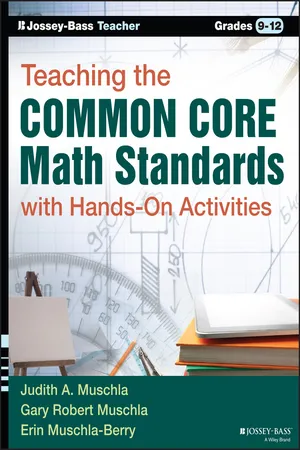Mathematics
Rational Expressions
Rational expressions are mathematical expressions that can be written as a ratio of two polynomials. They can include variables and have the form P(x)/Q(x), where P(x) and Q(x) are polynomials and Q(x) is not equal to zero. Rational expressions can be simplified, added, subtracted, multiplied, and divided using techniques similar to those for rational numbers.
Written by Perlego with AI-assistance
Related key terms
2 Key excerpts on "Rational Expressions"
- Gary Robert Muschla(Author)
- 2015(Publication Date)
- Jossey-Bass(Publisher)
Section 2Standards and Activities for Algebra
Seeing Structure in Expressions
An expression is a general term used to designate a symbolic mathematical form. An algebraic expression is an expression that contains a variable or a sum, difference, product, or quotient that contains one or more variables.A-SSE.1
“Interpret the structure of expressions.”
- 1. “Interpret expressions that represent a quantity in terms of its context.
- a. “Interpret parts of an expression, such as terms, factors, and coefficients.
- b. “Interpret complicated expressions by viewing one or more of their parts as a single entity.”
Activity: Interpreting Expressions
Working in pairs or groups of three, students will play a game in which they identify terms, factors, and coefficients of an expression. They will receive 1 point for each correct answer.Materials
Scissors; one copy of reproducible A-SSE.1, “The Expressions Game,” for each pair or group of students.Procedure
- Explain that an expression is a general, symbolic mathematical form that combines numbers, operation signs, and sometimes variables. Review the following:
- If an expression contains variables, it is called an algebraic expression. An example is 3n.
- If an expression is written as the sum of several quantities, each quantity is a term of the expression. In 3x + 2y, 3x and 2y are terms.
- If an expression is written or can be written as the product of two or more quantities, each quantity is a factor of the expression. When 4x + 8 is written as 4(x + 2), the factors are 4 and (x + 2).
- A coefficient of a variable is the numeral to be multiplied by the variable. In 7x, 7 is the coefficient of x.
- Explain that students will play a game in which they will name the terms of expressions, factors of expressions, and coefficients of variables. They will receive 1 point for each correct answer and no points for any incorrect answers. The students in each pair or group will play against each other.
- eBook - ePub
Effective Teaching Strategies for Dyscalculia and Learning Difficulties in Mathematics
Perspectives from Cognitive Neuroscience
- Marie-Pascale Noël, Giannis Karagiannakis(Authors)
- 2022(Publication Date)
- Routledge(Publisher)
6 Rational numbers
DOI: 10.4324/b22795-6A rational number is the quotient of two integers. Rational numbers are presented in three different notations: fractions (1/4), decimal numbers (0.25), and percentages (25%). During the last years of the primary school cycle (around fourth or fifth grade), the child is introduced to rational numbers. Mastering these rational numbers is important for school success already in primary schools, but also beyond. Thus, the knowledge of fractions is essential for more advanced mathematical achievement such as algebra, but is also a predictor of the ability to participate in the labour force in the United States (Geary, Hoard, Nugent & Bailey, 2012; Siegler & Pyke, 2013). Indeed, it has been observed that poor mastery of rational numbers prevents access to many middle- and high-income jobs (McCloskey, 2007). However, this learning is a problem for many students, including those in middle school or high school, mainly because they do not understand the meaning of these rational numbers.6.1 Learning rational numbers: a challenge!
Learning rational numbers is a real challenge for children. According to a study carried out by the French Community of Belgium (1996, unpublished), major difficulties persist in this learning among students in seventh or eighth grades (around the age of 13). For example, about 1 out of 4 students is unable to find a number between 2 decimal numbers (e.g., between 72.4 and 72.5), and half of them are unable to calculate a percentage (e.g., 21% of 6,200). Similarly, among a large sample of college students in the United States, only 33% correctly identified the largest of four fractions (Stigler, Givin & Thompson, 2010). One of the main reasons for this challenge is that children are facing a real conceptual shift, and the mistakes they make reveal misconceptions about rational numbers. Indeed, in many cases, the errors can be explained by the fact that students tend to view fractions and decimals as whole numbers and to apply to them the rules previously used on natural numbers. The interference of prior knowledge when learning rational numbers seems to be one of the main sources of difficulties and has been identified in the literature as the natural number bias
Learn about this page
Index pages curate the most relevant extracts from our library of academic textbooks. They’ve been created using an in-house natural language model (NLM), each adding context and meaning to key research topics.

